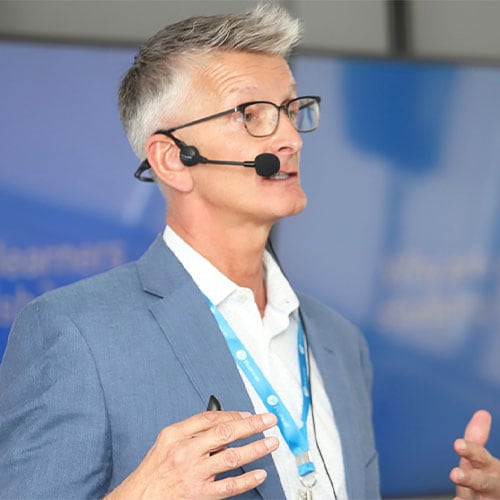The MENA region has emerged as a key player in global digital transformation and development. A recent McKinsey digital report on digital adoption in the Middle East revealed that the region boasts one of the highest digital engagement rates worldwide. In this rapidly evolving landscape, individuals and businesses are confronted with the critical necessity of adapting and acquiring new skills to thrive in the market. Both employers and employees must take proactive initiatives to invest in the skills and training necessary to remain competitive and drive innovation forward.
Employees themselves are responsible for actively pursuing knowledge and cultivating versatile skill sets that empower them to excel in their respective roles. Recent research suggests a huge appetite for learning and development among younger generations. According to a Deloitte survey, learning and development opportunities are the second highest priority for millennials and Gen Z workers when evaluating potential employers.
This means that employers in the region must recognize the importance of training and development to secure top talent and understand the significance of equipping their workforce with future-oriented skills, thus fostering an expert workforce capable of navigating the challenges presented by the modern workplace.
Employer's Role in Upskilling, Nurturing Talent and Fuelling Growth
Employers need to keep up with emerging technologies that have the potential to reshape industries and transform existing functions. According to PwC's workplace report, a significant majority of employees in Kuwait (75%), Qatar (60%), Saudi Arabia (58%), and the UAE (46%) believe that their countries are facing a scarcity of individuals with specialized skills. Despite this, respondents from the region display higher confidence compared to the global average (47% compared to 40% globally) in their employers' prioritization of upskilling.
Pearson, the world's largest learning company, designs programs to equip businesses, employees and HR leaders with the necessary skills for the future of work. The need for upskilling is partly related to the fact that formal education may only cover some of the necessary requirements. According to Pearson's Skills Outlook 2023 survey, carried out with 4,000 employees worldwide, individuals acknowledge that they will need to upskill to meet the demands of their careers.
Continuous Learning: Embracing the Future of Work
Professionals in the MENA region are beginning to embrace the idea of continuous learning as a means to adapt and succeed in the ever-changing job market. According to the World Economic Forum, over 60% of Middle East survey respondents consider specialist training an essential requirement in their jobs, surpassing the global average of 48%. This indicates that workers in the region are willing to enhance and diversify their skill sets, and it is now up to businesses to invest in their development to build a thriving workplace and increase profitability.
Skills such as digital literacy, creativity, deductive reasoning, and other future-oriented skills are in high demand. In a globalized economy, English proficiency also plays a crucial role, as a bridge connecting individuals from diverse cultures and facilitating seamless information-sharing worldwide. Globally, English is the lingua franca of business, a key to unlocking better communication. According to a report by Inc.com, ineffective communication can cost the average organization $62.4 million per year in lost productivity. The same report found that companies with effective communication generated a 47% higher return to shareholders over a five-year period.
Leveraging Tools for a Future-Ready Workforce
Nowadays, numerous resources are available to help businesses enhance their employees' language skills. One such tool is MondlyWorks by Pearson, which utilizes advanced technology to provide a personalized learning experience. This allows employees to improve their language proficiency at their own pace, seamlessly integrating lessons into their busy work schedules. It is designed to cater to specific industries, including hospitality, retail, banking, and customer service, making it a valuable addition to employees' benefit packages.
Recruiting top talent with the necessary skills for a role can be challenging for companies. Assessing a candidate's English skills can be time-consuming and subjective. However, with Pearson's Global Scale of English (GSE), a standardized measurement of English proficiency, recruitment companies can benefit from a detailed analysis of language skills and the framework to personalize learning pathways.
To this end, Pearson offers Versant, a fully automated digital assessment of language skills – speaking, writing, reading, and listening – that will be needed in the workplace. Auto-scored digital assessments such as Versant ensure that candidates from different educational and cultural backgrounds can be assessed at scale using the same objective criteria, providing fast and fair results to expand a company's diverse talent pool.
Upskilling for the future
English language proficiency is crucial for businesses seeking to remain competitive and for individuals exploring limitless career opportunities. A report conducted by the British Council highlights that English is spoken by an astounding 1.75 billion people, representing a remarkable one-quarter of the global population.
Today, most English speakers are people who have learned English as a second or additional language, many of whom use English for professional purposes. In dynamic workplaces, English proficiency serves as a catalyst for fostering essential skills such as effective communication, collaboration, and teamwork. Organizations that prioritize the development of English language proficiency can cultivate a workforce capable of driving regional ambitions and thriving in the global marketplace.




